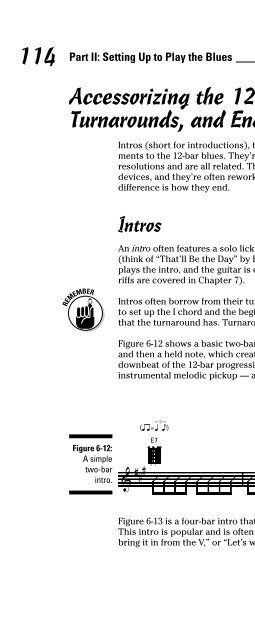238658923659
114 Part II: Setting Up to Play the Blues Accessorizing the 12-Bar Blues: Intros, Turnarounds, and Endings Intros (short for introductions), turnarounds, and endings are all enhancements to the 12-bar blues. They’re used to steer the song toward repeats or resolutions and are all related. There are countless variations for these three devices, and they’re often reworked versions of each other, where the only difference is how they end. Intros An intro often features a solo lick by the guitar, piano, or other instrument (think of “That’ll Be the Day” by Buddy Holly). But sometimes the whole band plays the intro, and the guitar is expected to play rhythm guitar (licks and riffs are covered in Chapter 7). Intros often borrow from their turnaround cousins, because the whole idea is to set up the I chord and the beginning of the progression — the same duties that the turnaround has. Turnarounds are covered in the next section. Figure 6-12 shows a basic two-bar intro. The rhythm features a syncopation and then a held note, which creates a musical space (or hole) before the downbeat of the 12-bar progression. This space allows room for a vocal or instrumental melodic pickup — a phrase that starts before bar one. TEAM LinG Track 27, 0:00 Figure 6-12: A simple two-bar intro. (qr=qce) E7 2 1 B7 213 4 Figure 6-13 is a four-bar intro that is just the last four bars of the 12-bar blues. This intro is popular and is often announced by a musician saying, “Let’s bring it in from the V,” or “Let’s walk it down from the V.”
- Page 212: Chapter 5: Positioning the Right Ha
- Page 216: Chapter 5: Positioning the Right Ha
- Page 220: Chapter 5: Positioning the Right Ha
- Page 224: Chapter 5: Positioning the Right Ha
- Page 228: Chapter 6 Blues Progressions, Song
- Page 232: Chapter 6: Blues Progressions, Song
- Page 236: Chapter 6: Blues Progressions, Song
- Page 240: Chapter 6: Blues Progressions, Song
- Page 244: Chapter 6: Blues Progressions, Song
- Page 248: Chapter 6: Blues Progressions, Song
- Page 252: Chapter 6: Blues Progressions, Song
- Page 256: Chapter 6: Blues Progressions, Song
- Page 260: Chapter 6: Blues Progressions, Song
- Page 266: Figure 6-15: A two-bar turnaround w
- Page 270: 118 Part II: Setting Up to Play the
- Page 274: 120 Part II: Setting Up to Play the
- Page 278: 122 Part II: Setting Up to Play the
- Page 282: Track 32, 0:00 Figure 7-4: An eight
- Page 286: The 5-6 riff is a blues-rhythm hall
- Page 290: Track 34 Shuffle (qr=qce) A 3 T A B
- Page 294: Intro, turnaround, and ending riffs
- Page 298: If the double strikes in the bass g
- Page 302: Track 37, 0:33 Figure 7-19: A low-n
- Page 306: 136 Part II: Setting Up to Play the
- Page 310: In this part . . . This part dives
114 Part II: Setting Up to Play the Blues Accessorizing the 12-Bar Blues: Intros,<br />
Turnarounds, and Endings<br />
Intros (short for introductions), turnarounds, and endings are all enhancements<br />
to the 12-bar blues. They’re used to steer the song toward repeats or<br />
resolutions and are all related. There are countless variations for these three<br />
devices, and they’re often reworked versions of each other, where the only<br />
difference is how they end.<br />
Intros<br />
An intro often features a solo lick by the guitar, piano, or other instrument<br />
(think of “That’ll Be the Day” by Buddy Holly). But sometimes the whole band<br />
plays the intro, and the guitar is expected to play rhythm guitar (licks and<br />
riffs are covered in Chapter 7).<br />
Intros often borrow from their turnaround cousins, because the whole idea is<br />
to set up the I chord and the beginning of the progression — the same duties<br />
that the turnaround has. Turnarounds are covered in the next section.<br />
Figure 6-12 shows a basic two-bar intro. The rhythm features a syncopation<br />
and then a held note, which creates a musical space (or hole) before the<br />
downbeat of the 12-bar progression. This space allows room for a vocal or<br />
instrumental melodic pickup — a phrase that starts before bar one.<br />
TEAM LinG<br />
Track 27, 0:00<br />
Figure 6-12:<br />
A simple<br />
two-bar<br />
intro.<br />
(qr=qce)<br />
E7<br />
2 1<br />
B7<br />
213 4<br />
Figure 6-13 is a four-bar intro that is just the last four bars of the 12-bar blues.<br />
This intro is popular and is often announced by a musician saying, “Let’s<br />
bring it in from the V,” or “Let’s walk it down from the V.”



